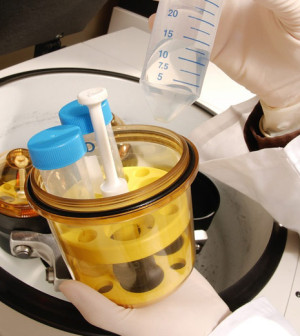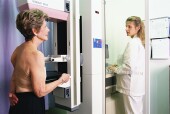- Skip Storing This Everyday Product in the Fridge Door
- Green Tea + B3 Pairing May Boost Brain Health
- Navigating Your Midlife Crisis: Embracing New Possibilities
- City Raccoons Showing Signs of Domestication
- Mapping the Exposome: Science Broadens Focus to Environmental Disease Triggers
- One Week Less on Social Media Linked to Better Mental Health
- Your Brain Changes in Stages as You Age, Study Finds
- Some Suicide Victims Show No Typical Warning Signs, Study Finds
- ByHeart Formula Faces Lawsuits After Babies Sickened With Botulism
- Switch to Vegan Diet Could Cut Your Greenhouse Gas Emissions in Half
New Device May Make Mammograms More Comfortable


Dutch researchers have developed a device that may reduce the discomfort many women feel during a mammogram while preserving the quality of the image.
Breast compression is necessary in mammography for imaging purposes, but it can be painful. The new device displays the average pressure during compression, so the pressure can be adjusted and standardized, which reduces pain, according to the researchers.
Currently, mammographers can only estimate the pressure applied to the breasts, according to study researcher Woutjan Branderhorst, from the Academic Medical Center in Amsterdam and a scientist at Sigmascreening, the company developing the device.
Funding for the study was provided by Pink Ribbon, an organization that supports breast cancer research and awareness, and Sigmascreening, a spin-off company of the Academic Medical Center.
Those who perform mammograms have a difficult task, Branderhorst explained. They must ”adjust the applied compression force to breast size, composition, skin tautness and pain tolerance,” he said.
Currently, he said, the technologist doing the mammogram can only use visual and tactile clues to estimate the pressure on the breast. This results in large variations, Branderhorst said.
”Especially for small breasts, this can lead to extremely high pressure,” he added.
“The device used in our study measures and displays the pressure in real time, which provides an objective guide for the technologists and enables standardization of the pressure,” Branderhorst said.
This makes the procedure less uncomfortable because high, painful pressures are avoided, he said.
In their study, Branderhorst and his team performed mammograms on more than 400 women undergoing routine mammograms. The researchers theorized that a protocol based on pressure, not force, would make the tests more comfortable.
Using the new device, they did four compressions on each woman. Three were standardized to a specific force; one was standardized to a specific target pressure.
The mammogram targeted for pressure was rated as less painful, on average, by the women. The pressure-targeted mammogram didn’t reduce image quality, Branderhorst noted.
Existing mammography machines could be upgraded with the device, Branderhorst said, and the device could be integrated into new machines. The extra costs would be minimal, he predicted.
Branderhorst is scheduled to present the results of the study on Sunday at the annual meeting of the Radiological Society of North America in Chicago. Findings presented at meetings are generally considered preliminary until they’ve been published in a peer-reviewed journal.
Dr. Lusi Tumyan, chief of breast imaging at the City of Hope Cancer Center in Duarte, Calif., reviewed the findings. “It looks promising and it looks interesting, but it is too early to tell,” she said.
Currently, she said, mammographers use visual clues to determine how much pressure to apply. “If a patient is uncomfortable we don’t press as much.”
If the research bears out, she said, the device might also help standardize the mammograms from year to year.
However, Tumyan said, since the number of women in this study was small, more studies would be needed.
More information
To learn more about what to expect during a mammogram, visit National Cancer Institute.
Source: HealthDay
Copyright © 2025 HealthDay. All rights reserved.










